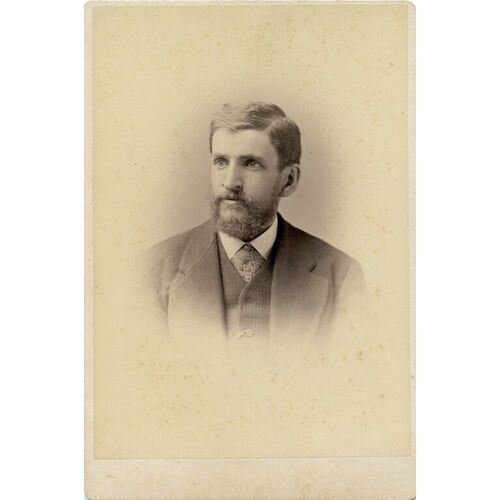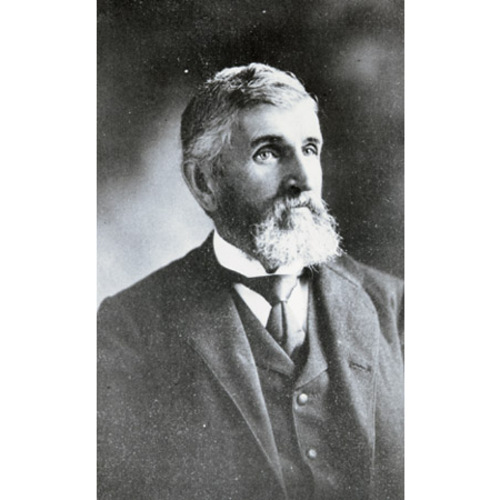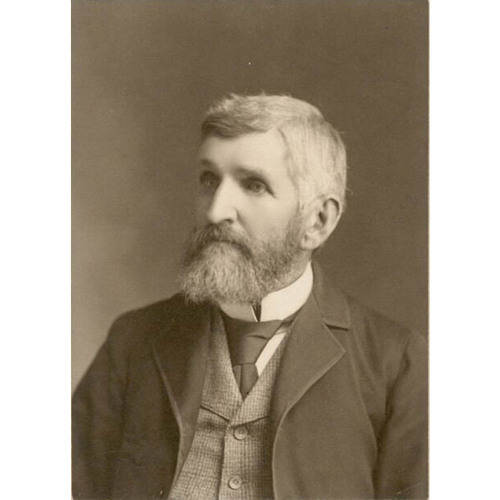
Source: Link
BAILEY, LORING WOART, educator, geologist, botanist, and author; b. 28 Sept. 1839 in West Point, N.Y., son of Jacob Whitman Bailey and Maria Slaughter; m. 19 Aug. 1863, in Fredericton, Laurestine Marie Marshall d’Avray, only child of Joseph Marshall* de Brett Maréchal, Baron d’Avray, and they had five sons and two daughters; d. 10 Jan. 1925 in Fredericton.
Loring Woart Bailey was introduced to scientific circles by his father, first professor of chemistry, mineralogy, and geology at the United States Military Academy in West Point. Eminent American and European scientists visited their home and as a youth he joined his father and brothers in botanical and geological field observations. He was educated at schools in Maryland and Rhode Island before entering Harvard University in Cambridge, Mass., in 1855. There he studied under the geologist Louis Agassiz, the botanist Asa Gray, and the chemist Josiah Parsons Cooke. His ab degree in 1859 was followed by a period of further study in chemistry at Brown University in Providence, R.I. He then returned to Harvard, where he served as assistant to Cooke, who in 1861 recommended him, at the age of 21, for the post of professor of chemistry and natural science at the University of New Brunswick. He would receive his ma from Harvard the following year.
Arriving in Fredericton in the summer of 1861, Bailey found his prime duty was to teach, which he did with enthusiasm, skill, and devotion for 46 years. One of his early students, George Robert Parkin, recalled later that “the introduction to Natural Science was like the opening of a new world to me, and it gave me just the intellectual stimulation I needed.” Initially, Bailey was a one-man natural science faculty, covering the broad spectrum of physics, chemistry, zoology, botany, and geology, but in 1900 his sphere was reduced to biology and geology. To illustrate his lectures he collected geological and botanical specimens, and added them to the museum cabinets started by his predecessor, James Robb*. He valued museums as educational tools and lamented the attitudes of people who regarded them as “a mere collection of curiosities.” His appeals for financial support from the provincial legislature, however, fell on deaf ears.
His enthusiasm for teaching was matched by his dedication to research; in New Brunswick’s complex geology he found a pristine and potentially rich area for investigation. In 1863 Lieutenant Governor Arthur Hamilton Gordon*, anxious to promote the development of the province’s resources, paid for him to carry out a mineralogical survey. After consulting the geological map prepared by Robb and partially based on Abraham Gesner*’s reports of 1839–43, he selected a wilderness route along the Saint John, Tobique, and Nepisiguit rivers in order to examine metalliferous rocks of the Cambrian series (which then included a portion of the Ordivician); en route he visited the mines in Woodstock and Bathurst. The following year he accompanied George Frederic Matthew and Charles Frederick Hartt* on a survey of the southern part of the colony including the complicated geological formations east of Saint John. Their discovery of a band of slates with embedded Cambrian fossils provided a key to the age of similar rocks in New England. Reports of these expeditions presented to the legislature in 1864 and 1865 are classics in New Brunswick’s scientific literature.
In 1864 as well, Henry Youle Hind* was employed by the government to survey the northern part of the province. Although Bailey and Matthew received no pay, Hind, under the misapprehension that he was to be appointed provincial geological surveyor, viewed their activities as a threat and attacked them scurrilously in the press. He cited Bailey’s youth, American nationality, and lack of experience as detrimental and suggested that Bailey should attend solely to his university duties. This acrimonious dispute led New Brunswick to abandon sponsorship of further geological surveys.
After confederation the director of the Geological Survey of Canada, Sir William Edmond Logan*, met with Bailey and Matthew in 1868 to discuss the survey’s expansion to New Brunswick. Once again Bailey was employed in the summers. Accompanied by Matthew or by assistants such as Robert Wheelock Ells, he surveyed the southern half of the province and later the northern counties along the Saint John River, together with adjoining areas of Quebec and Maine, as well as southern Nova Scotia. Bailey’s discovery of Silurian fossils in northern New Brunswick suggested that rocks of that region covered a wider range of geological time than had previously been supposed. His survey results were published in a series of GSC reports over the years 1872–1906. Together with Ells he also reported on the coalfields of central New Brunswick and mapped the area of bituminous shales in Albert and Westmorland counties. His philosophical bent is apparent in overviews of geological problems such as his 1897 paper entitled “The Bay of Fundy trough in American geological history.” He was greatly admired for undertaking arduous field work in spite of having a lame leg, injured in a childhood accident.
The challenge of teaching and research and happiness in his marriage kept Bailey at the University of New Brunswick although he had tempting offers from American colleges. His home became a centre for students, visitors, and neighbours interested in science and literature, attracted by his wife’s social gifts and Bailey’s lively conversation. He also promoted science in the community, helping a neighbour, John Babbitt*, to experiment with new inventions, including the telephone and electric lighting. He lectured at the Mechanics’ Institute in Saint John and was an honorary member of the Natural History Society of New Brunswick, giving an annual lecture to that body and contributing to its Bulletin. A charter member of the Royal Society of Canada, he was president of his section in 1888–89 and 1918–19.
While still a student, he had completed a scientific paper, started by his father, on the diatoms (plankton) of the Pará River in Brazil. In retirement he renewed this interest. Working sometimes in cooperation with the Biological Board of Canada and the Atlantic Biological Station at St Andrews, N.B., he identified diatoms of the Bay of Fundy, the coast of Prince Edward Island, and other parts of the east coast. His expertise became so widely recognized that he received specimens from the Pacific coast and Alberta and Saskatchewan lakes. The results were published in various Canadian and American scientific journals and later brought together in “An annotated catalogue of the diatoms of Canada,” issued a few months before his death. Altogether he was the author of around 100 scientific works, several of which were major publications.
Bailey’s place among eminent geologists of the province was recognized in 1899 when fellow naturalist William Francis Ganong* named a northern New Brunswick mountain after him. His pioneering work in provincial geology enriched his teaching and his influence as a teacher is attested by the success of students such as Ganong and William Diller Matthew (G. F. Matthew’s son), whose early training enabled them to undertake graduate work at prestigious universities; later they contributed to the broader world in botany and palaeontology. Honours bestowed on Bailey included a phd from the University of New Brunswick in 1873 and an lld from Dalhousie University in 1896.
Bailey’s writings are listed in the biography by Joseph Whitman Bailey mentioned below, as well as in Science and technology biblio. (Richardson and MacDonald). Among his publications is a tribute to his colleague George Frederic Matthew in RSC, Trans., 3rd ser., 17 (1923): vii–x. His annotated catalogue of diatoms appears in Biological Board of Canada, Contributions to Canadian biology, being studies from the biological stations of Canada (Toronto), 2 (1925), no.2: [31]–67.
The main primary source for Loring Woart Bailey and his family is the Bailey family fonds at the Univ. of N.B. Library, Arch. and Special Coll. Dept. (Fredericton), MG H1. There are photographs of Bailey in the archives and in the university’s dept. of biology. His botanical collections are preserved in the department’s Connell Memorial Herbarium, and some of his geological specimens are in the dept. of geology.
Daily Evening Globe (Saint John), 25 April 1864. Daily Gleaner (Fredericton), 10 Jan. 1925. J. W. Bailey, Loring Woart Bailey, the story of a man of science (Saint John, 1925). R. A. Jarrell, “Science education at the University of New Brunswick in the nineteenth century,” Acadiensis (Fredericton), 2 (1972–73), no.2: 55–79. Kenneth Johnstone, The aquatic explorers: a history of the Fisheries Research Board of Canada (Toronto, 1977). RSC, Trans., 3rd ser., 19 (1925), proc.: xiv—xv. Morris Zaslow, Reading the rocks: the story of the Geological Survey of Canada, 1842—1972 (Toronto and Ottawa, 1975).
Cite This Article
C. Mary Young, “BAILEY, LORING WOART,” in Dictionary of Canadian Biography, vol. 15, University of Toronto/Université Laval, 2003–, accessed September 4, 2024, https://www.biographi.ca/en/bio/bailey_loring_woart_15E.html.
The citation above shows the format for footnotes and endnotes according to the Chicago manual of style (16th edition). Information to be used in other citation formats:
| Permalink: | https://www.biographi.ca/en/bio/bailey_loring_woart_15E.html |
| Author of Article: | C. Mary Young |
| Title of Article: | BAILEY, LORING WOART |
| Publication Name: | Dictionary of Canadian Biography, vol. 15 |
| Publisher: | University of Toronto/Université Laval |
| Year of publication: | 2005 |
| Year of revision: | 2005 |
| Access Date: | September 4, 2024 |





